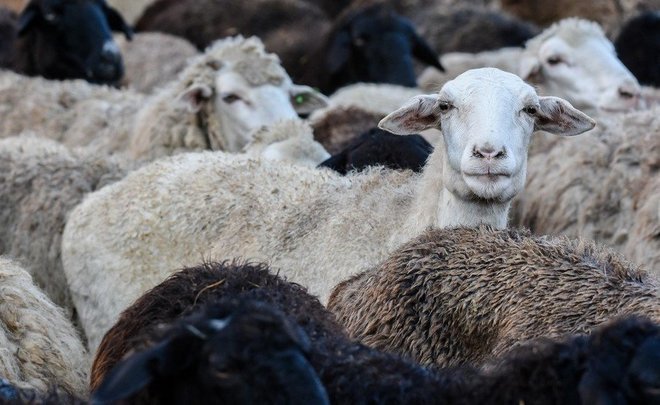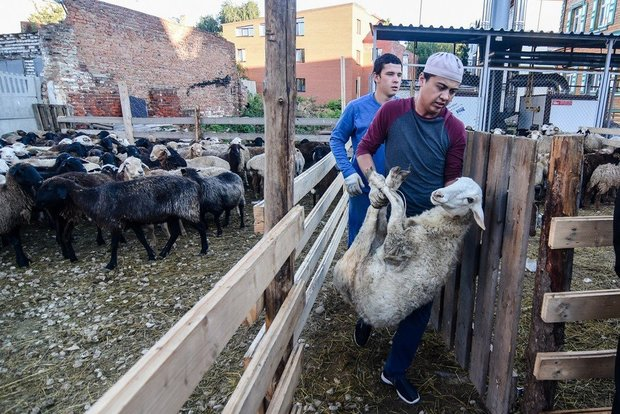Foot-and-mouth disease, smallpox and brucellosis detected in regions on the eve of Feast of Sacrifice
The scale of upcoming religious sacrifices is the reason for concern: 15,000 animals were killed last year, 17,000 are expected in 2022

An adverse situation with the foot-and-mouth disease and smallpox in cattle has unfolded in more than 30 Russian regions. Trying to prevent the entrance of ill animals to the region, Tatarstan authorities recommend buying Tatarstan sheep for the upcoming Feast of Sacrifice — to support local producers at the same time. Any imported sheep will be carefully examined, vaccinated cattle won’t be let pass, and even after all non-Tatarstan sheep are brought they will be put in quarantine. The causes and the scale of the upcoming religious animal sacrifices during the key Muslim holiday: 15,000 animals were slaughtered on officials sites alone in 2021, 17,000 are expected to be killed in 2022. Read more in Realnoe Vremya’s report.
In what regions the situation is unfavourable
As vice head of the Main Veterinary Office of the Tatarstan Cabinet of Ministers Gabdulkhak Motygullin explained at a press conference on 26 May, they have to talk about veterinary and sanitary well-being at the Feast of Sacrifice on 9 July only now because animals for the key Muslim holiday are brought to Tatarstan in advance. There is a fear because of another “complicated situation” with animals’ infectious diseases in other regions that traditionally breed small cattle (particularly sheep). The situation is the following:
- 31 Russian regions are unfavourable regarding the foot-and-mouth disease today. As for the closest to Tatarstan, it is Orenburg, Samara and Saratov Oblasts.
- 32 regions are considered adverse when it comes to brucellosis, including Orenburg, Penza, Saratov Oblasts, Perm Krai;
- 30 regions including Nizhny Novgorod Oblast have been declared unfavourable because of sheep and goat smallpox.
Nowadays it is prohibited to bring sheep and small cattle in general to Tatarstan from these regions — not those who have the disease, but vaccinated animals only because they are vaccinated in those regions that have some diseases. Tatarstan is considered “favourable” because there is no vaccination here.
“If vaccinated cattle is brought here, the laboratory will show they are ill. Because the cattle isn’t permitted to be brought to Tatarstan,” Motygullin explained. “Not only animals contract the above-enumerated diseases, all three are dangerous for human too. During those years when Tatarstan specialists coped with brucellosis, veterinarians with animal breeders fell ill too. While brucellosis is incurable, fingers, joints constant ache then. Because of the foot-and-mouth disease, the patient develops ulcers in the mouth, people cannot eat then, only through a tube.”
“We were sometimes brought non-standard, ‘defective” animals”
Not to bring small cattle infections from the above-mentioned regions, Tatarstan authorities offer to simply buy sheep in the republic itself. It is good, Motygullin noted, that head of sheep grows year after year, today the republic has about 300,000 small cattle. There is a “sufficient amount” of sheep for the domestic holiday, there is no need in buying them some else, the Tatarstan government claims.
“So we will protect the republic from diseases and at the same time notably support our citizens who breed sheep. The imported sheep, moreover, isn’t better than our breeds. We were sometimes brought non-standard, ‘defective’ animals that don’t correspond to religious requirements by the Feast of Sacrifice. For instance, an animal hasn’t reached even a year, it is a lamb. Or there are some bodily defects, a torn ear, a broken horn, the weight below the average. Such animals often fall ill,” said the vice director of the Main Veterinary Office of the Tatarstan Cabinet of Ministers.
There is just one reason why such sheep are sold — according to religious rules or, more precisely, tradition during the Soviet era, it is prohibited to bargain when buying an animal for sacrifice for the feast. Resellers purchasing it for 3,000 per head but selling for 8-10,000 here take advantage of this.
Imported cattle will be put in quarantine, even healthy cattle
Today there are certain requirements for cattle imports in Tatarstan. Firstly, an animal or herd must be brought from a favourable region without diseases. Secondly, the import must be approved by the chief veterinarian of the region it is brought from. Also, every lot requires a veterinarian document, and after being imported it is necessary to inform the veterinarian service of the city or district because imported animals will have to be put in quarantine.
“Sheep may seem healthy when loading them, but signs of the disease will certainly come about in quarantine,” Motugyllin explained.
The cattle that has already been brought or sheep purchased in the republic will be slaughtered on official sacrifice sites that have strict requirements: they must have a hard floor, devices to weight the cattle, containers for water and waste. Organisers of animal sacrifice at the same time must provide waste disposal after the Feast of Sacrifice is over. Public services will disinfect the site.
15,000 animals were officially sacrificed last year
It is noteworthy German company Saria (a resident of Alabuga Special Economic Zone) will install the containers and deal with disposal. The company felt quite well before the spring sanctions having 4,2 billion rubles of turnover in 2021, which is 1,2 billion more than in 2020. Next year’s net income tripled reaching a record 1,2 billion rubles.
50 official sites, of which 18 are in Kazan, will be organised for animal sacrifice. Representatives of the Main Veterinary Office will work there because there are a lot of people who want to give sacrifice meat to social institutions, which needs veterinarian documents — “otherwise such institutions cannot accept the meat” (especially if children are fed).
To compare, about 15,000 animals were sacrificed on official sites alone during the feast in 2021. It is impossible to count how many were sacrificed in total because nobody prohibits sacrifices in the countryside. At the same time, 5,700 head were sacrificed in Kazan, as a result of which about 60 tonnes of waste was disposed of by Saria.
“Earlier, especially in Kazan and big cities, because of biological waste that remained after the feast, we received complaints, it was unpleasant. There haven’t been almost such moments [recently],” claimed Motygullin.

Work is done on the road to prevent imports of ill animals. According to Artur Zagidullin, state inspector of the department of the State Veterinarian Inspection of the Tatarstan office of Russia’s Russian agricultural watchdog, 143 violations have been detected in Tatarstan in 2022. Transportation of animals without veterinary documents is the main violation.
“Family houses” go extinct, Feast of Sacrifice mostly celebrated in cities
When talking about putting order during the Feast of Sacrifice, especially in Kazan, Chairman of the Central Revision Commission of the Tatarstan Muslim Religious Directorate Hazrat Rustem Valiullin sadly remembered those years when there was a way to go to the job done to “normalise and make animal sacrifices look in a civilised way.”
“If you remember, 10-15 years ago, every year was accompanied by unpleasant comments of inspectors. As a believer I didn’t like the situations when a sacrifice was made in the city and the site wasn’t cleaned. There were few people of this kind, but they were easy to spot, those who didn’t tidy up,” he said.
The extinction of “family houses” is the reason why the holiday moved from the Tatar countryside to big Tatarstan cities. The countryside accounted for a lion’s share of sacrifices when people return to their villages for the Feast of Sacrifice and made a holy sacrifice. But many of such houses have almost disappeared — families moved to cities or suburban settlements.
“But it becomes harder to do agricultural activity in settlements year after year, people don’t like if you keep animals. However, now 18 sites for animal sacrifice for the feast are organised in Kazan. In 2021, we held the feast in a centralised and systematic way. Saria company started to help from the first days. Its representatives tried to understand us — they have their own requirements for waste, we try to meet these requirements. Last year, it seemed we finally made sure there weren’t any complaints,” Rustem Valiullin noted.
Rise in religious moods: 17,000 head expected to be sacrificed this year
By the way, he explained two key requirements for sacrifice animals and why the religious directorate works with the Russian agricultural watchdog and other supervisory agencies works closely on this issue: the sacrifice animal must be healthy and it cannot be a lamb.
“There is an opinion that it is not nice to bargain, but there was a tradition in the USSR because it wasn’t easy to hold the feast during those years — it was both prohibited ideologically and hard to find a mullah. Of course, there was no bargaining then. And here we would like people to understand the buyer should look,” claimed Valiullin.
To correctly choose an animal, he recommended consulting an imam of the closest mosque that will hold the feast this year. Valiullin also urged people not to sacrifice animals on the very first day.
“In the countryside, one can afford staying during the sacrifice, feel a part of the process. For instance, I don’t have the time and possibilities to observe. At the end of the third day, we, mullahs, sacrifice our sheep. Then there is more time and we are told that it is time for ours. Many order a sacrifice on the first day and the first day is so busy, the second or third days can be free,” he explained.
However, in the last few years, the second day has started being busier at least by half — but the third day of the feast remains almost free (Editor’s note: that’s to say, nobody makes a sacrifice on this day). The directorate, as he assured the audience, doesn’t permit leaving somebody’s sacrifice on the fourth day, there is why one should not hurry.
Interestingly, according to his data, a rise in sacrifice animals is expected this year in Tatarstan — up to 17,000 head will be sacrificed. Another 50-60 cattle head will be sacrificed too. The directorate thinks that a rise among Tatarstan Muslims is already seen, Ramadan already showed this.
“The people was tired during the pandemic and became very active during Ramadan. Many understood that values changed for the better,” Valiullin claimed.